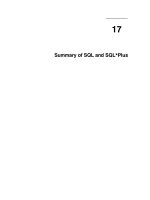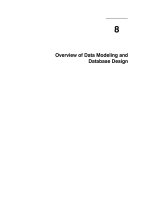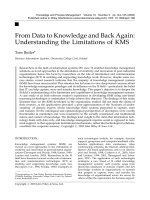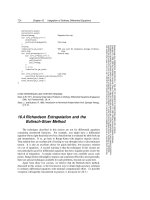Tài liệu Feaculty of Computer Science and Engineering Department of Computer Scienc Tutorial 3 Questions pdf
Bạn đang xem bản rút gọn của tài liệu. Xem và tải ngay bản đầy đủ của tài liệu tại đây (534.36 KB, 4 trang )
Faculty of Computer Science and Engineering
Department of Computer Science
1/4
DATA STRUCTURES & ALGORITHMS
Tutorial 3 Questions
Recursion and Binary Tree
Part 1. Recursion
Required Questions
Question 1.
What would be the contents of queue Q1 after the following code is executed and the
following data are entered?
1 Q1 = createQueue
2 S1 = createStack
3 loop (not end of file)
1 read number
2 if (number not 0)
1 pushStack (S1, number)
3 else
1 popStack (S1, x)
2 popStack (S1, x)
3 loop (not empty S1)
1 popStack (S1, x)
2 enqueue (Q1, x)
4 end loop
4 end if
4 end loop
The data are: 9, 5, 10, 4, 0, 5, 4, 6, 8, 67, 32, 25, 51, 0, 54, 23, 20, 6, 10
Question 2.
The following algorithm is to reverse a queue
Algorithm reverse (val q <Queue>)
Pre true
Return a reversed queue of q
1 S = createStack
2 Q = createQueue
3 while (not empty(q))
1 dequeue(q,temp)
2 pushStack(S,temp)
4 while (not empty(S))
1 popStack(S,temp)
2 enqueu (Q,temp)
4 return Q
End reverse
Develop a similar algorithm to append a stack to a queue
Algorithm append (val q <Queue>, val s <Stack>)
Pre true
S1=
Q1=
5, 4, 6, 8, 67, 32,9,5
10,6,20,23,54
Algorithm append ((val q <Queue>, val s
<Stack>))
Pre true
Return a reversed queue of q
1 S = createStack
2 Q = creatQueue
3 while(not empty(S))
1 popStack(S,temp)
2 enqueue(q,temp)
4
while(not empty(q))
1
reverse(Q)
5
dequeue(q,temp)
2
enqueue(Q,temp)
6
return Q
End append
Faculty of Computer Science and Engineering
Department of Computer Science
2/4
Return element of s is appended into q with the same order. For
example if q = {1,2,3}, s = {4,5,6} then q = {1,2,3,4,5,6} after
append.
Queue {front rear}
Stack {bottom top}
Question 3.
Consider the following algorithm:
Algorithm fun1 (x <integer>)
1 if (x < 5)
1 return (2 * x)
2 else
1 return (2 * fun1 (x – 2) + 5)
3 end if
end fun1
What would be returned if fun1 is called as
a. fun1 (4)?
b. fun1 (5)?
c. fun1 (8)?
d. fun1 (20)?
Question 4.
Develop recursive algorithm for the following problems.
a. Compute the sum of all numbers from 1 to n, where n is given as parameter.
Algorithm compute (val n <integer>)
Pre n >=0
Return the sum 0 + 1+ 2+ 3+ + n
b. Find and return the maximum element in an array, where the array and its size are
given as parameters.
Algorithm compute (val a <array>, val n <integer> )
Pre n >=0
Return the maximum element in a[]
Advanced Questions
Question 5.
Develop recursive algorithm for the following problems.
a. Find and return an element in an array, where the array and its size are given as
parameters. This element should be in middle position when the array is re-
ordered increasingly.
8
17
47
(2*(2*2
Algorithm compute (x <integer>)
1 if (x =0)
1 return (0)
2 else
1 return (n+compute(n-1))
3 end if
aánh
Algorithm compute (val a <array>, val n <integer> )
1. if (n=0)
1 return a[0]
2.else
return (compute(a,n)>compute(a,n-1))?compute(a,n):compute(a,n-1)
3233
6,5,4
4,5,6
Faculty of Computer Science and Engineering
Department of Computer Science
3/4
Algorithm compute (val a <array>, val n <integer> )
Pre n >=0
Return the the element in the middle position when the array
is reordered increasingly in a[]
For example if a = {4,1,5,2,3}, then the value of the last element should
be returned.
b. Could we design an algorithm for solving question (a) without sorting the array?
Algorithm compute (val a <array>, val n <integer> )
Pre n >=0
Return the the element in the middle position when the array
is reordered increasingly in a[]
Question 6.
Develop algorithms for the following problems. The algorithms must be fully recursive
in that they contain no loops at all (neither for, while or do-while).
a.
Algorithm listnumber (val start <integer>, val end <integer>)
Pre start <=end
Return printout the numbers from start to end to screen
b.
Algorithm mul (val a <integer>, val b <integer>)
Pre a,b >=0
Return the product of two integers a and b. The only two
arithmetic operations that you are allowed to use in this
problem are addition + and subtraction -
c.
Algorithm pow (val a <float>, int b <integer>)
Pre a,b >=0
Return the power a
b
. The only two arithmetic operations that
you are allowed to use in this problem are multiple * and
subtraction -
Question 7.
Develop fully recursive algorithms for the functions reverse and append in Question 2
return (start<=end)?end:listnumber(start-1,end)
if(b=1) return a;
else
return a+mul(a,b-1)
return (b==1)?a:a+mul(a,b-1)
return (b==1)?a:a*pow(a,b-1)
append (Queue*Q,Stack *S)
Pre true
Return a reversed queue of q
S=new Stack();
Q = new Queue();
while(S->top!=NULL)
popStack(S,temp)
enqueue(q,temp)
while(Q->front!=NULL)
reverse(Q)
dequeue(q,temp)
enqueue(Q,temp)
End append
return Q
Faculty of Computer Science and Engineering
Department of Computer Science
4/4
Part 2. Binary Tree
Required Questions
Question 8.
For each of the following key sequences determining the binary search tree obtained
when the keys are inserted one-by-one in the order given into an initially empty tree:
a) 1, 2, 3, 4, 5, 6, 7.
b) 4, 2, 1, 3, 6, 5, 7.
c) 1, 6, 7, 2, 4, 3, 5.
Question 9.
For each of the binary search trees obtained in Question 1, determine the tree obtained
when the root is withdrawn.
Question 10.
Write a global function in pseudocode to generate a BST from an input list by insert
elements in the list into an initial empty BST. Refer to Question 1 for an example.
algorithm generateBSTfromList (val list <List>)
This algorithm generate a BST from the input list
Pre
Post the BST is built by inserting elements in the list into an initial empty tree
one-by-one from the beginning of the list.
Return the BST
end generateBSTfromList
Advanced Questions
Question 11.
Devise an algorithm that takes two values, a and b such that a < b, and which visits all
the keys x in a binary search tree such that a x b.
1
2
3
4
5
6
7
1
2
3
4
5
6
7
1
2
3
4
6
7
1
2
3
4
6
7
5
2
6
7
4
5
3
1
2
3
5
6
7
1. if (subroot is NULL)
1. Allocate subroot
2. subroot->data = DataIn
3. return success
2. else if (DataIn.key < subroot->data.key)
1. return recursive_Insert(subroot->left, DataIn)
3. else if (DataIn.key > subroot->data.key)
1. return recursive_Insert(subroot->right, DataIn)
4. else
1. return duplicate_error
5. End recursive_Insert









